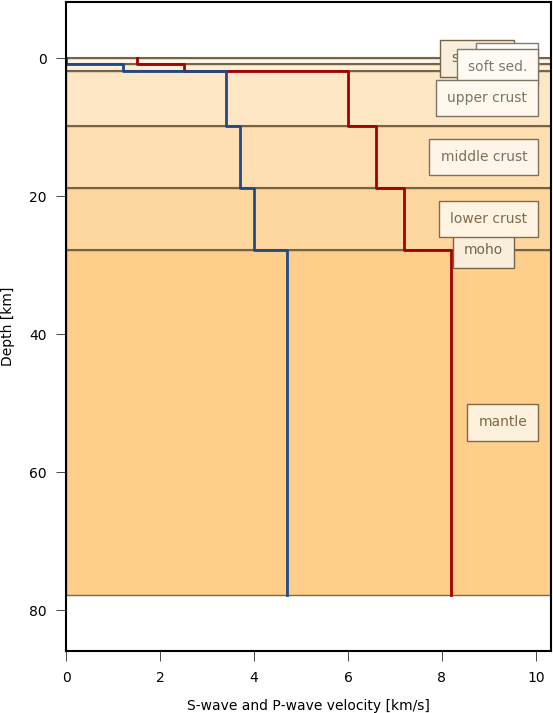Accessing crustal velocity databases¶
Crust 2.0 Database¶
The CRUST 2.0 3 is a global 2x2 degree velocity model of the earth’s crust. Each individual profile is a 7 layer 1D-model.
Citation
- 3
Bassin, C., Laske, G. and Masters, G., The Current Limits of Resolution for Surface Wave Tomography in North America, EOS Trans AGU, 81, F897, 2000.
Accessing the Crust 2x2 database¶
Here we utilize the pyrocko.dataset.crust2x2 module to query the Crust 2.0 database
>>> from pyrocko import crust2x2
>>> profile = crust2x2.get_profile(23., 59.)
>>> print profile
type, name: T9, thin Margin /shield transition, 1 km seds.
elevation: -764
crustal thickness: 26000
average vp, vs, rho: 6587.3 3695.6 2907.7
mantle ave. vp, vs, rho: 8200 4700 3400
0 3810 1940 920 ice
764 1500 0 1020 water
1000 2500 1200 2100 soft sed.
0 4000 2100 2400 hard sed.
8000 6000 3400 2700 upper crust
9000 6600 3700 2900 middle crust
9000 7200 4000 3100 lower crust
Inspect the Crust2.0 database with cake¶
We can use pyrocko.cake to access the data and handle the velocity model with cake.
>>> from pyrocko import cake, cake_plot
>>> model = cake.load_model(fn=None, crust2_profile=(23., 59.))
>>> cake_plot.my_model_plot(model)

Global Crustal Database¶
The Global Crustal Database 4 gathers empirical 1D velocity models from seismic reflection and refraction profiles. As of 2013 there are 138939 profiles, mainly P and fewer S wave records in the database.
Citation
- 4
W.D. Mooney, G. Laske and G. Masters, CRUST 5.1: A global crustal model at 5°x5°. J. Geophys. Res., 103, 727-747, 1998.
from pyrocko import crustdb
cdb = crustdb.CrustDB()
europe = cdb.selectLocation(lat=52., lon=20., radius=15.)\
.selectMinDepth(20)
europe.plot(plot_median=False, plot_mode=False)
europe.plot(plot_median=False, plot_mode=False, vrange=(2000, 6000), phase='s')

Other selection methods are selectPolygon() and
selectRegion().
See dataset for more information on the API.